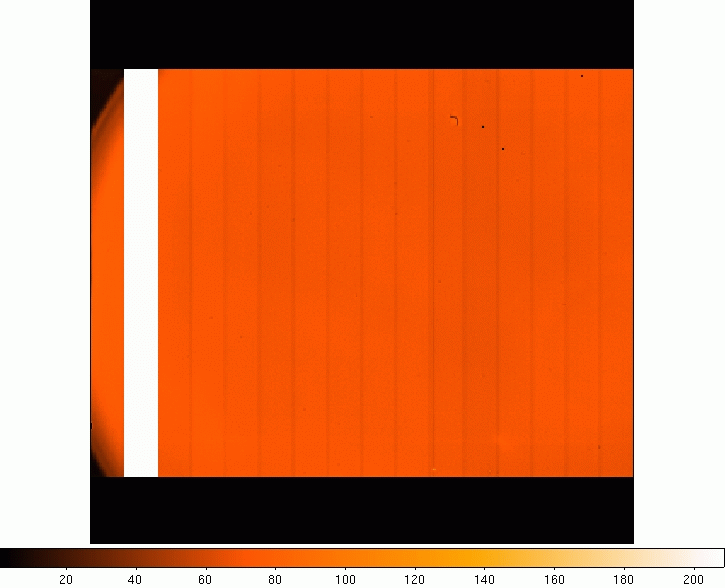Bad Channel in Michelle
You are here
Implications of the Bad Channel in Michelle
Following a warm up and cool down cycle of Michelle around the start of 2008, which was required to improve the contact between the detector and the cold finger, it was found that one of the 16 channels in Michelle was no longer functioning properly. The signal from that channel appears to scale directly with the frame time, such that it is saturated for any exposure time that is used on the sky. The channel is therefore useless for any Michelle observations. This page discusses the implications of this for the various observing modes of Michelle. An example of how a raw frame looks with the bad channel is shown below.
The channel that is bad is the second channel from the left on the array, columns 21 to 40. As a result the effective area of the array for imaging is now 280 by 240 pixels, or about 28 by 24 arc-seconds on the sky. This does not have any practical impact for most of the imaging observations that are done with Michelle, especially in view of the limitation of the chop throw to 15 arc-seconds or less. If any Michelle user wishes to observe objects that are larger than 28 arc-seconds they should contact one of the Michelle support astronomers (James Radomski & Rachel Mason) to access how the observations will be affected by the bad channel. For observations of objects that are smaller than 15 arc-seconds in diameter the observations can be arranged so that the bad channel does not affect the data.
For low resolution N-band spectroscopy the bad channel can be avoided by changing the central wavelength from 10.5 microns to 9.5 microns. This is now the default value in the Michelle OT library. When this is done the full available wavelength coverage across the N-band window falls in columns 41 to 240 on the array. Therefore low-N spectroscopy mode is not impacted by the bad channel.
For the the low resolution Q-band spectroscopy mode a similar change of the central wavelength may be required, but this will depend on what features are of interest in any particular program. For the current default central wavelength of 20.5 microns the bad channel will affect the spectrum between 16.5 and 17.2 microns. If the spectrum is shifted 40 pixels on the array to avoid the bad channel this will eliminate the spectral coverage beyond about 24.5 microns. As there have been no low-Q programs in the queue recently we have not taken the time to investigate exactly how the central wavelength would need to be changed in this mode to produce the maximum effective spectral coverage.
In the higher resolution medN1, medN2, and echelle spectral modes the bad channel will obviously affect the wavelength coverage of a single setting. For users that want continuous spectral coverage this means that the wavelength settings will need to give roughly 1/16 overlap between adjacent settings. In the N-band medN2 mode a wavelength spacing of 0.4 microns between exposures produces the required overlap. For the medN1 mode a wavelength spacing of 1.0 microns will provide complete spectral coverage. For the echelle mode the bad channel will be an issue if the velocity range that is needed is larger than ~800 km/s, in which case two wavelength settings would be needed for complete coverage.

